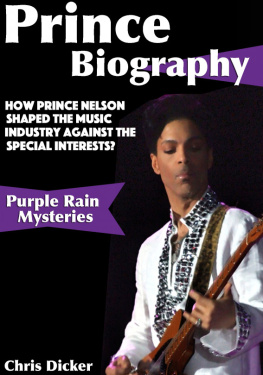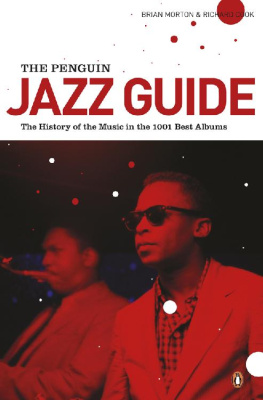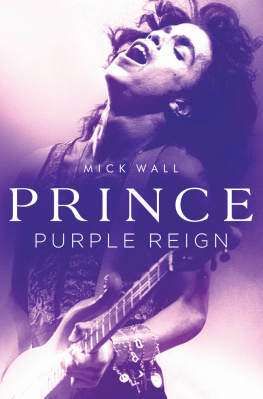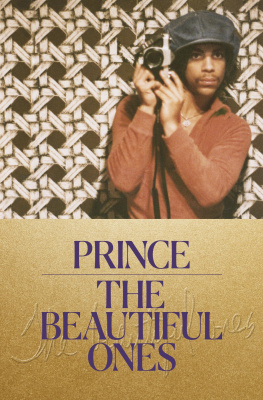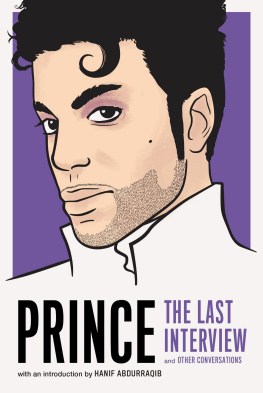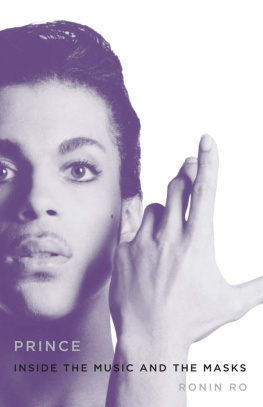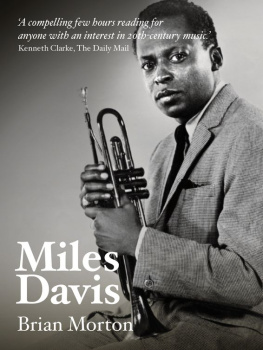PRINCE
A THIEF IN THE TEMPLE
Brian Morton

This edition first published in 2007 by
Canongate Books Ltd, 14 High Street,
Edinburgh EH1 1TE
This digital edition first published in 2016 by Canongate Books
Copyright Brian Morton, 2007
The moral rights of the author have been asserted.
British Library Cataloguing-in-Publication Data
A catalogue record for this book is available on request from the British Library.
ISBN 978 1 78211 975 3
Typeset by Palimpsest Book Production Ltd,
Grangemouth, Stirlingshire
www.canongate.tv
Sarah, for you...
... and for the little prince.
Contents
Acknowledgements
In a story so much concerned with rumour, counter-rumour, carefuly confected legend, fallings-out, gagging clauses and plain nonsense, who to believe? Almost every detail of Princes childhood and early years is rebutted or contradicted somewhere in the record. Almost everything that happened later is the subject of endless speculation in an internet community whose size and passion is the best evidence of Princes artistic longevity. Special thanks to all those imaginatively handled visitors to chat-rooms and message boards, but also to those whove written about Prince before me, and particularly Barney Hoskyns and Dave Hill, whose books Imp of the Perverse and A Pop Life offered a useful confirmation at a later stage of writing that I wasnt wildly off the mark. Thanks to Arthur Geffen, my virtual guide to Minneapolis, who could have been appalled to know what he was guiding me towards; to the late Colin Smith; to Robert Palmer, Mica Paris, Andrew Pothecary, Cindy Revell; to Jamie Byng, Andy Miller, Helen Bleck and Alison Rae of Canongate Books, who put up with long delays during the unhappy period after I left the BBC and changed my name to an unpronounceable squiggle and my writing style to an unreadable scrawl; to the members and ex-members of the Prince entourage who spoke (mostly) off the record but with more obvious affection and admiration than malice, and who are paraphrased rather than quoted anonymously in what follows. Thanks above all to Sarah The Most Beautiful Girl in the World for putting up with endless plays of endless Prince albums, singles and bootlegs, and for being there during the SLAVE/squiggle days. And to Prince, who I met once semi-officially and from whom I got not one word of sense, except a shared admiration for Miles Davis.
Introduction
The story of Prince like those of his friend and collaborator Miles Davis, and his fellow Minnesotan Bob Dylan confirms the falsehood of F. Scott Fitzgeralds famous line about there being no second acts in American lives. The myth of America is all about successive rebirth, about self-determination, about putting time into reverse and seeming to grow younger rather than older. If America is also a language experiment, then archetypal Americans and Prince, Miles, Dylan inhabit that category almost always take a playfully cavalier attitude to their own creations.
Its about time, in both the words senses. If Dylan can take a cherished song and put it to a reggae beat or slow it down so drastically that only a few stray lyrics seem familiar; if Miles could turn his back as he notoriously used to do on stage on his own part in some of the classic jazz albums and in favour of youthful street music; then Prince has followed them in treating his own astonishing body of songs many hundreds in the public domain, countless others as yet unheard as if they were counters on an improvisational game-field, part of an open flow of work rather than canonical works. The hard thing for any student of Prince, but an endless source of delight and discovery for his admirers, is that the real work does not come through to us as settled product but as a tricksterish chase after bootlegs, reworked ideas, wilful suppressions and mere rumour. It has kept him, depending on how you look at it, either ahead of everyone else, or in sole charge of his own enigmatic game.
The time frame is important. As a very young man, Prince appeared to be the most exciting musician in America, uniquely allowed by a major corporation to make his own music exactly as he chose. Not much more than a decade later, Prince or whatever he then called himself was a laughing-stock, paranoid, conspiratorial, creatively burned out, broke. Its hard to judge whether his disappearance from the scene was a personal crisis like the drug-fuelled disillusion that drove Miles Davis away from active music-making at the end of the 1970s or was part of a capriciously contrived withdrawal like Bob Dylans much exaggerated motorcycle accident. Whatever the truth, all three men came back, Miles and Dylan with something new in their music, Prince seemingly content to catch up with some of the unexplored dimensions of his own almost absurdly eclectic past where a single record might contain elements of jazz, funk, rnb, bubblegum pop, psychedelia and hard rock.
The comeback wasnt quite overnight. Prince signalled his intention to be part of the new millennium with 2001s jazz-inflected Rainbow Children, which seemed to be largely concerned with his becoming a Jehovahs Witness. Two years later, and this time on the nomadic NPG imprint which allowed him to preserve some degree of creative if not distributional independence, he released N.E.W.S., a set of rough jams that didnt sound like a finished record at all. A year further on, though, an artist who had seemed creatively and commercially down and out was again the biggest gross earner in the music business. Neither 2004s Musicology nor 2006s 3121, his first album for Universal, were anything other than professional, generic Prince records. He seemed to have defied an iron law and to have cheated time. Pushing fifty, Prince had renewed himself.
Hes always talked about in terms of a Zeitgeist, one which he either expressed to perfection or actually created and inhabited alone. Prince is often spoken of as an enigma, which is rarely a helpful designation. There is, though, a paradox at the heart of his work and reputation. Recent commercial recognition might suggest that Prince was ahead of his time and the market has only now caught up. Prince, though, enjoyed enormous commercial success when still very young 1984s Purple Rain is an industry benchmark and was only critically marginalised when his behaviour and his music became erratic in the latter part of the decade. He enjoyed greater freedom than any comparable artist in the corporate system and yet presented himself as a SLAVE, another African-American whose creative identity was in thrall to the system. He seems to represent a definite moment in cultural time, and yet when one thinks of 1978 or 1979 or the turn into the following decade, it isnt Prince who sums up those years and it isnt Prince who has left a host of successors. For all its apparent attachment to a supposed cusp in American popular culture, Princes work is about itself, driven by its own rules, prodigal enough to seem even more expansive than it actually was.
To adapt the James Thurber cartoon: what did Prince want to be enigmatic for? The answer is that it was very good for business. He chose his collaborators carefully, didnt always treat them with gratitude but almost always with an element of paranoia; he understood the music business brilliantly and particularly the importance of publishing, the main term of his enslavement but at the price of having always to work outside its mainstream. In this regard, he more closely resembles a jazz musician, for whom a measure of marginality is almost inevitable given the imperatives of the culture and the nature of improvisation, and he most closely resembles the older Miles Davis with whom he had a brief on-off friendship and collaboration after Miless return to performance in the 1980s. Working with his own capriciously evolving circle of collaborators recruits from the classical world and from Stevie Wonders band, influences as far apart as Stockhausen and hip-hop the trumpeter had enjoyed huge commercial success, but at the same cost. The price of creative independence is a certain distance from the mainstream. Unquestionably Prince learned from Miles Daviss example and brokered a unique position for an African-American artist. He made, lost and remade a fortune by giving the public exactly what it wanted, while pretending to refuse such accommodation. For a black man in America, it was a subtle and risky strategem.


